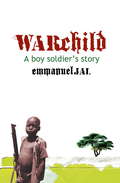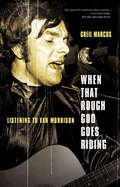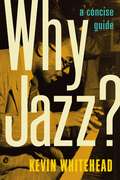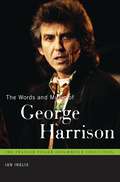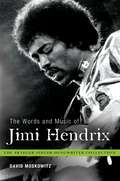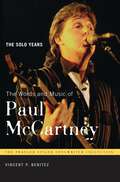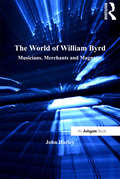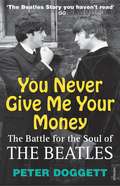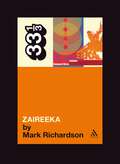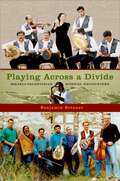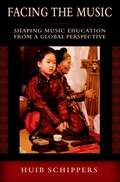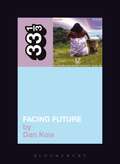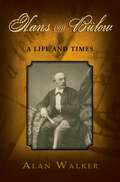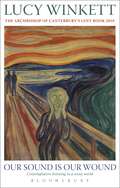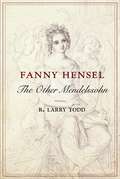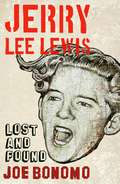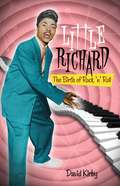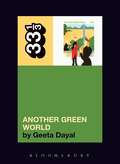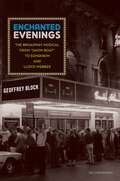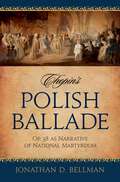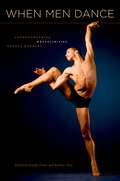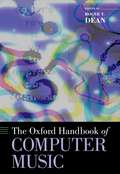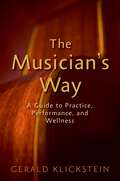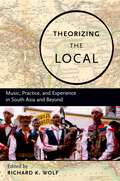- Table View
- List View
War Child: A Boy Soldier's Story
by Emmanuel JalEmmanuel Jal was only seven years old when he was taken from his family home to become a child soldier with the rebel army in Sudan's bloody civil war for nearly five years. Beaten, starved and brutalised Emmanuel was put into battle in Ethiopia and southern Sudan carrying an AK-47 talller than himself.He attempted to leave the SPLA but was hunted down and thrown into a desert prison. He finally escaped and is now an internationally-acclaimed rap artist spreading messages of peace and reconciliation with his unique style of gospel rap.
When That Rough God Goes Riding: Listening to Van Morrison
by Greil MarcusThis book is a quest to understand Van Morrison's particular genius through a close look at the most extraordinary and unclassifiable moments in his long career, beginning in 1965 and continuing in full force to this day: sometimes entire songs, sometimes single words or even the guttural spaces between words that become musical events in themselves.
Why Jazz?: A Concise Guide
by Kevin WhiteheadWhat was the first jazz record? Are jazz solos really improvised? How did jazz lay the groundwork for rock and country music? In Why Jazz?, author and NPR jazz critic Kevin Whitehead provides lively, insightful answers to these and many other fascinating questions, offering an entertaining guide for both novice listeners and long-time fans. Organized chronologically in a convenient question and answer format, this terrific resource makes jazz accessible to a broad audience, and especially to readers who've found the music bewildering or best left to the experts. Yet Why Jazz? is much more than an informative Q&A; it concisely traces the century-old history of this American and global art form, from its beginnings in New Orleans up through the current postmodern period. Whitehead provides brief profiles of the archetypal figures of jazz--from Louis Armstrong and Duke Ellington to Wynton Marsalis and John Zorn--and illuminates their contributions as musicians, performers, and composers. Also highlighted are the building blocks of the jazz sound--call and response, rhythmic contrasts, personalized performance techniques and improvisation--and discussion of how visionary musicians have reinterpreted these elements to continually redefine jazz, ushering in the swing era, bebop, cool jazz, hard bop, and the avant-garde. Along the way, Why Jazz? provides helpful plain-English descriptions of musical terminology and techniques, from "blue notes" to "conducted improvising." And unlike other histories which haphazardly cover the stylistic branches of jazz that emerged after the 1960s, Why Jazz? groups latter-day musical trends by decade, the better to place them in historical context. Whether read in self-contained sections or as a continuous narrative, this compact reference presents a trove of essential information that belongs on the shelf of anyone who's ever been interested in jazz.
The Words and Music of George Harrison (The Praeger Singer-Songwriter Collection)
by Ian InglisThis book offers a comprehensive assessment of the music of George Harrison, revealing him as one of the most gifted and authentic singer-songwriters of his generation.The Words and Music of George Harrison is an in-depth appreciation of this often underappreciated musician, following Harrison's development as a singer-songwriter from his earliest songs with The Beatles through his final album, Brainwashed, released after his 2001 death from brain cancer.The Words and Music of George Harrison sheds new light on Harrison's 40-year career, examining his music output in the context of the enormous personal and professional changes he underwent, from the early days in Liverpool and the global explosion of Beatlemania through a solo career marked by spiritual concerns, political activism, and high-profile collaborations. As the book shows, at every stage, George Harrison's songs posed questions, provided commentaries, and looked for solutions, with results that add up to a remarkable music legacy.
The Words and Music of Jimi Hendrix (The Praeger Singer-Songwriter Collection)
by David V. MoskowitzThis comprehensive discussion of the singer/songwriter/guitarist's life carves autobiographical details from the lyrics of his song catalog.Jimi Hendrix was a rock 'n' roll guitar god and remains an important rock icon, still popular despite the four decades that have passed since his death in 1970. The Words and Music of Jimi Hendrix uses Hendrix's music—including the posthumous album Valleys of Neptune, released on March 9, 2010—to shed light on the details of the singer/songwriter's all-too-brief life.Organized chronologically, the book provides an in-depth look at Hendrix's life, carving autobiographical details from his lyrics. At the same time, it offers readers a better understanding of the superstar's music and the forces behind it. The book focuses on the three albums released during Hendrix's life, as well as the major posthumous works. Priority is also given to touring and to the influence of other guitarists.
The Words and Music of Paul McCartney: The Solo Years (The Praeger Singer-Songwriter Collection)
by Vincent P. Jr.This examination of the solo music of Paul McCartney, from 1970-2007, offers an analysis of his songs, recordings, and his impact on popular music.The Words and Music of Paul McCartney: The Solo Years examines the large and varied oeuvre of this deeply personal artist, showing how McCartney's stint as a Beatle continues to inform his solo music, as well as how he has transcended his days as a member of the Fab Four. After a biographical introduction, chronologically arranged chapters explore McCartney's music in the immediate aftermath of the breakup of the Beatles, his work with Wings during the 1970s, his collaborations with other artists during the 1980s, and his compositions of the 1990s, including his first forays into classical music. The examination also covers McCartney's critically acclaimed work in the first decade of the 21st century, including Memory Almost Full and Ecce Cor Meum, a composition written in the style of sacred English choral music. Throughout, the book supplies analytical insights and historical background to a repertoire that, surprisingly, has not previously been covered in detail.
The World of William Byrd: Musicians, Merchants and Magnates
by John HarleyIn The World of William Byrd John Harley builds on his previous work, William Byrd: Gentleman of the Chapel Royal (Ashgate, 1997), in order to place the composer more clearly in his social context. He provides new information about Byrd's youthful musical training, and reveals how in his adult life his music emerged from a series of overlapping family, business and social networks. These networks and Byrd's navigation within and between them are examined, as are the lives of a number of the individuals comprising them.
The World of William Byrd: Musicians, Merchants and Magnates
by John HarleyIn The World of William Byrd John Harley builds on his previous work, William Byrd: Gentleman of the Chapel Royal (Ashgate, 1997), in order to place the composer more clearly in his social context. He provides new information about Byrd's youthful musical training, and reveals how in his adult life his music emerged from a series of overlapping family, business and social networks. These networks and Byrd's navigation within and between them are examined, as are the lives of a number of the individuals comprising them.
You Never Give Me Your Money: The Battle For The Soul Of The Beatles
by Peter DoggettWhen Paul McCartney told the world in 1970 that he had no plans to work with the Beatles again, it was widely viewed as a cultural tragedy by the media and public alike. But one of the most fascinating phases of the Beatles' story was just about to begin. Now, for the first time, You Never Give Me Your Money tells the dramatic story of the Fab Four post 1969. It charts the almost Shakespearean rivalry of the Lennon and McCartney families, the conflict in George Harrison's life between spirituality and fame, and Richard Starkey's efforts to conquer his personal demons. It also chronicles the transformation of their multi-media company, Apple Corps, from a bastion of 1960s counter-culture into a corporate behemoth. From court battles to chart success, the best of rock'n'roll writers, Peter Doggett traces the untold story of a group and a legacy that will never be forgotten.
Flaming Lips' Zaireeka (33 1/3)
by Mark RichardsonZaireeka is the anti-headphone and the anti-mp3. It purposely makes the two biggest developments in end-user music in the last 30 years irrelevant. Zaireeka is not mobile. It is not personal. It is not solitary, cannot be easily controlled, and can't easily be consumed in small doses. So another way to think of Zaireeka is as a one-off piece of technology that comes in a highly inconvenient dead-end format. The Flaming Lips' 1997 album Zaireeka is one of the most peculiar albums ever recorded, consisting of four CDs meant to be played simultaneously on four CD players. Approaching this powerful and complex art-rock masterpiece from multiple angles, Mark Richardson's prismatic study of Zaireeka mirrors the structure the work itself. Thoughts on communal listening and the "death of the album" are interspersed with the story of the Zaireeka's creation (with assistance from Wayne Coyne) and an in-depth analysis of the music, leading to a complete picture of a record that proved to be a watershed for both the band and adventurous music fans alike.
Playing across a Divide: Israeli-Palestinian Musical Encounters
by Benjamin BrinnerIn the last decade of the twentieth century and on into the twenty-first, Israelis and Palestinians saw the signing of the Oslo Peace Accords, the establishment of the Palestinian Authority, the assassination of Israeli Prime Minister Yitzhak Rabin, and the escalation of suicide bombings and retaliations in the region. During this tumultuous time, numerous collaborations between Israeli and Palestinian musicians coalesced into a significant musical scene informed by these extremes of hope and despair on both national and personal levels. Following the bands Bustan Abraham and Alei Hazayit from their creation and throughout their careers, as well as the collaborative projects of Israeli artist Yair Dalal, Playing Across a Divide demonstrates the possibility of musical alternatives to violent conflict and hatred in an intensely contested, multicultural environment. These artists' music drew from Western, Middle Eastern, Central Asian, and Afro-diasporic musical practices, bridging differences and finding innovative solutions to the problems inherent in combining disparate musical styles and sources. Creating this new music brought to the forefront the musicians' contrasting assumptions about sound production, melody, rhythm, hybridity, ensemble interaction, and improvisation. Author Benjamin Brinner traces the tightly interconnected field of musicians and the people and institutions that supported them as they and their music circulated within the region and along international circuits. Brinner argues that the linking of Jewish and Arab musicians' networks, the creation of new musical means of expression, and the repeated enactment of culturally productive musical alliances provide a unique model for mutually respectful and beneficial coexistence in a chronically disputed land.
Facing the Music: Shaping Music Education from a Global Perspective
by Huib SchippersFacing the Music investigates the practices and ideas that have grown from some five decades of cultural diversity in music education, developments in ethnomusicology, and the rise of 'world music'. Speaking from rich, hands-on experience of more than thirty years at various levels of music education (music in schools, community organizations and professional training courses), Huib Schippers makes a powerful case for the crucial role of learning music in shaping rich and diverse musical environments for the 21st century, both in practical terms and at a conceptual level: "what we hear is the product of what we believe about music." Advocating a contemporary, positive and realistic approach to cultural diversity in music education and transmission, Schippers advocates taking into account and celebrating the natural dynamics of music. He argues that "most music travels remarkably well", and regards every musical act as an expression of the 'here and now', as do many of the musicians and scholars he quotes. In this way, he challenges stifling directives to recreate 'authentic contexts', which in fact constantly change (and have always changed) in the cultures of origin as well. This liberates music educators to seek with integrity appropriate ways of presenting music at all levels of education: in schools, community settings, and professional training. In seven succinct chapters that each approach the issues from a different angle, Schippers gradually unfolds the complexities of learning and teaching music 'out of context' in an accessible manner, and presents a coherent model to approach these, as well as lucid suggestions for translating the resulting ideas in practice. While mapping the various factors that determine all acts of music transmission, he also comes to surprising insights into the nature and preconceptions underlying much formal music education settings across the world, including those focusing on western classical music. Facing the Music provides a rich resource for reflection and practice for all those involved in teaching and learning music, from policy maker to classroom teacher.
Israel Kamakawiwo'ole's Facing Future (33 1/3)
by Dan KoisEven at four in the morning, the strip clubs and watering holes surrounding the Honolulu studio were still hopping. The recording engineer heard a car pull into the lot, and soon the biggest man he had ever seen walked in. When he stepped into the studio, the floated floor shifted beneath the engineer's feet. Israel Kamakawiwo'ole engulfed the engineer's hand in his and said, "Hi, bruddah." The product of that impromptu recording session, a delicate medley of "Somewhere Over the Rainbow" and "What a Wonderful World," has driven sales of Facing Future to nearly two million copies. Each time the medley is licensed to appear in advertisements, in movies, even on American Idol, Mainlanders embrace it anew as a touch of the unfamiliar in their otherwise staid record collections. But in Hawai'i, a state struggling with the responsibility of its native heritage, Facing Future is much more. Gaining unprecedented access to Israel's family, friends, and colleagues, Dan Kois tells the remarkable story of Bruddah Iz and the album that changed his life-and his death.
Hans Von Bülow: A Life and Times
by Alan WalkerHans von Bülow is a key figure in 19th century music whose career path was as broad as it was successful. Music history's first virtuoso orchestral conductor, Bülow created the model for the profession-both in musical brilliance and in domineering personality-which still holds forth today. He was an eminent and renowned concert pianist, a respected (and often feared) teacher and music critic, an influential editor of works by Bach, Mendelssohn, Chopin, and Beethoven, and a composer in a variety of musical genres. As a student and son-in-law of Franz Liszt, and estranged friend of Richard Wagner (for whom his wife Cosima famously left him), Bülow is intricately connected with the canonical greats of the period. Yet despite his critical and lasting importance for orchestral music, Bülow's life and significant achievements have yet to be heralded in biographical form. In Hans von Bülow: A Life and Times, Alan Walker, the acclaimed author of numerous award-winning books on the era's iconic composers, provides the first full-length English biography of this remarkable musical figure. Walker traces Bülow's life in illuminating and engaging detail, from the first piano lessons of his boyhood days, to his first American tour, to his last days as conductor of the Berlin Philharmonic. Unearthing Bülow's extensive and previously unavailable correspondence and writings, Walker conveys amusing and informative anecdotes about this unique musical legend- from his sardonic and clever personality to his meticulous devotion to his work-and reveals enlightening insights on the still-contested sensibilities of musical-compositional style and "idea" at play in the vibrant musical world of which Bülowwas a part.
Our Sound is Our Wound: Contemplative Listening to a Noisy World -- The Archbishop of Canterbury's Lent Book 2010
by Lucy WinkettThis book is a meditation on how we listen for the voice of God within the soundscapes of our lives, and how we find our own voice.
Fanny Hensel: The Other Mendelssohn
by R. Larry ToddGranddaughter of the philosopher Moses Mendelssohn and sister of the composer Felix Mendelssohn Bartholdy, Fanny Hensel (1805-1847) was an extraordinary musician who left well over four hundred compositions, most of which fell into oblivion until their rediscovery late in the twentieth century. In Fanny Hensel: The Other Mendelssohn, R. Larry Todd offers a compelling, authoritative account of Hensel's life and music, and her struggle to emerge as a publicly recognized composer.
Jerry Lee Lewis: Lost and Found
by Joe BonomoA superb new study of Jerry Lee Lewis that's as intense and fast paced as the life of "The Killer" himself, from the height of fame to the bumpy road that followed"The category in which Jerry Lee Lewis truly belongs is 'Jerry Lee Lewis.' The Killer is as big as Mount Rushmore, and he's also as American, as revered, as clichéd, as misunderstood, as corny, and as taken for granted as that monument. The curse of iconoclastic American success. Elvis felt it, so does Dylan. So will others who haven't been born yet."The story of Louisiana hellcat Jerry Lee Lewis and his 1958 wedding scandal-it was discovered that at 22 he had married his 13-year old second cousin, Myra, before he was divorced from his second wife-long ago took precedence over the man himself and the music he makes. In Jerry Lee Lewis: Lost and Found, author Joe Bonomo lets others focus on the scandal and delves more deeply into the accidental intersection between fading American Rockabilly and ascending Beatlemania. By first taking a look at the critical years before his famed night in 1964 at West Germany's Star-Club - what that meant not only for him but the entire live album-making world - then the tumultuous years that follow, culminating in his time on the American Country charts in the late 60s/ early 70s, Bonomo brings Jerry Lee Lewis to life in new and fascinating ways.In spite of plummeting record sales and concert fees, a media savaging of his personal character, a change of record labels and management, and a considerable upturn in his drug and alcohol abuse, Jerry Lee Lewis has persevered. In between being betrayed and ignored, he would record one of the greatest rock & roll performances in history. Bonomo's thorough research includes new interviews with Live at the Star-Club producer Sigi Loch, members of the Nashville Teens, and other musicians and fans who were at the Star-Club performance, as well as with music industry figures ranging from famed Nashville producer Jerry Kennedy and legendary Memphis stalwart Jim Dickinson to Killer-influenced contemporaries John Doe and Dave Alvin. This passionate book examines and explains the almighty impact of the Father of Rock'n'Roll.
Little Richard: The Birth of Rock 'n' Roll
by David KirbyA brilliant new biography of the extraordinary, outrageous performer who helped open the floodgates of Rock 'n' Roll. In June, 2007, Little Richard's 1955 Specialty Records single, "Tutti Frutti," topped Mojo magazine's list of "100 Records That Changed the World." But back in the early 1950s, nobody gave Little Richard a second glance. It was a time in America where the black and white worlds had co-existed separately for nearly two centuries. After "Tutti Frutti," Little Richard began garnering fans from both sides of the civil rights divide. He brought black and white youngsters together on the dance floor and even helped to transform race relations.Little Richard: The Birth of Rock 'n' Roll begins by grounding the reader in the fertile soil from which Little Richard's music sprang. In Macon, Georgia, David Kirby interviews relatives and local characters, who knew Little Richard way back when, citing church and family as his true inspiration. His antics began as early as grade school, performing for his classmates every time the teacher would leave the room, connecting to an age-old American show biz tradition of charade and flummery. On the road, Little Richard faced competition from his peers, honing his stage show and making it, too, an act that could not be counterfeited.Kirby sees Little Richard as a foxy warrior, fighting with skill and cunning to take his place among the greats. In the words of Keith Richards (on hearing "Tutti Frutti" for the first time), "it was as though the world changed suddenly from monochrome to Technicolor." Those sentiments have consistently been echoed by the music-listening world, and the time is ripe for a reassessment of Little Richard's genius and legacy.
Brian Eno's Another Green World (33 1/3)
by Geeta DayalThe serene, delicate songs on Another Green World sound practicallymeditative, but the album itself was an experiment fueled byadrenaline, panic, and pure faith. It was the first Brian Eno album tobe composed almost completely in the confines of a recording studio,over a scant few months in the summer of 1975. The album was a proofof concept for Eno's budding ideas of "the studio as musicalinstrument," and a signpost for a bold new way of thinking aboutmusic.In this book, Geeta Dayal unravels Another Green World's abundantmysteries, venturing into its dense thickets of sound. How was analbum this cohesive and refined formed in such a seemingly ad hoc way?How were electronics and layers of synthetic treatments used to createan album so redolent of the natural world? How did a deck of cardsfigure into all of this? Here, through interviews and archivalresearch, she unearths the strange story of how Another Green Worldformed the link to Eno's future -- foreshadowing his metamorphosisfrom unlikely glam rocker to sonic painter and producer.
Enchanted Evenings: The Broadway Musical from 'Show Boat' to Sondheim and Lloyd Webber
by Geoffrey BlockThis new second edition of Enchanted Evenings offers theater lovers an illuminating behind-the-scenes tour of some of America's best loved, most admired, and most enduring musicals. Readers will find such all-time favorites as Show Boat, Carousel, Kiss Me, Kate, Guys and Dolls, My Fair Lady, West Side Story, Sweeney Todd, Sunday in the Park with George, and Phantom of the Opera. Geoffrey Block provides a documentary history of each of the musicals, showing how each work took shape and revealing, at the same time, how the American musical evolved from the 1920s to today, both on stage and on screen. The book's particular focus is on the music, offering a wealth of detail about how librettist, lyricist, composer, and director work together to shape the piece. Block also includes trenchant social commentary and lively backstage anecdotes. Jerome Kern, Cole Porter, the Gershwins, Rodgers and Hart, Kurt Weill, Rodgers and Hammerstein, Lerner and Loewe, Frank Loesser, Leonard Bernstein, Stephen Sondheim, Andrew Lloyd Webber, and other luminaries emerge as hardworking craftsmen under enormous pressure to sell tickets without compromising their dramatic vision. The second edition includes a greatly expanded chapter on Sondheim, a new chapter on Lloyd Webber, and two new chapters on the film adaptations of the main musicals featured in the text (including such hard to find films as the original 1936 version of Anything Goes and the 1959 film adaptation of Porgy and Bess). Packed with information, including a complete discography and plot synopses and song-by-song scenic outlines for each of the fourteen shows, Enchanted Evenings is an essential reference as well as a riveting history. "A solid and fascinating work that should become a model of how to investigate and report on the evolution of a musical. Block's research is persuasive and his writing vivid. . . Indispensable for anyone who cares to know more about Broadway musicals than Playbill can provide." --Steven Bach, The Los Angeles Times Book Review
Chopin's Polish Ballade: Op. 38 as Narrative of National Martyrdom
by Jonathan D. BellmanChopin's Polish Ballade examines the Second Ballade, Op. 38, and how that work gave voice to the Polish cultural preoccupations of the 1830s, using musical conventions from French opera and amateur piano music. This approach provides answers to several persistent questions about the work's form, programmatic content, and poetic inspiration.
When Men Dance: Choreographing Masculinities Across Borders
by Jennifer Fisher Anthony ShayWhen Men Dance explores the intersection of dance and perceptions of male gender and sexuality across history and different cultural contexts. Chapters tackle the history and dilemmas that revolve around dance and notions of masculinity from a variety of dance studies perspectives, and are accompanied by fascinating personal histories that complement their themes.
The Oxford Handbook of Computer Music (Oxford Handbooks)
The Oxford Handbook of Computer Music offers a state-of-the-art cross-section of the most field-defining topics and debates in computer music today. A unique contribution to the field, it situates computer music in the broad context of its creation and performance across the range of issues - from music cognition to pedagogy to sociocultural topics - that shape contemporary discourse in the field. Fifty years after musical tones were produced on a computer for the first time, developments in laptop computing have brought computer music within reach of all listeners and composers. Production and distribution of computer music have grown tremendously as a result, and the time is right for this survey of computer music in its cultural contexts. An impressive and international array of music creators and academics discuss computer music's history, present, and future with a wide perspective, including composition, improvisation, interactive performance, spatialization, sound synthesis, sonification, and modeling. Throughout, they merge practice with theory to offer a fascinating look into computer music's possibilities and enduring appeal.
The Musician's Way: A Guide to Practice, Performance, and Wellness
by Gerald KlicksteinIn The Musician's Way, veteran performer and educator Gerald Klickstein combines the latest research with his 30 years of professional experience to provide aspiring musicians with a roadmap to artistic excellence. Part I, Artful Practice, describes strategies to interpret and memorize compositions, fuel motivation, collaborate, and more. Part II, Fearless Performance, lifts the lid on the hidden causes of nervousness and shows how musicians can become confident performers. Part III, Lifelong Creativity, surveys tactics to prevent music-related injuries and equips musicians to tap their own innate creativity. Written in a conversational style, The Musician's Way presents an inclusive system for all instrumentalists and vocalists to advance their musical abilities and succeed as performing artists.
Theorizing the Local: Music, Practice, and Experience in South Asia and Beyond
by Richard WolfOver the past four decades, the "globalized" aspects of cultural circulation have received the majority of scholarly-and consumer-attention, particularly in the study of South Asian music. As a result, a broad range of community-based and other locally focused performance traditions in the regions of South Asia have remained relatively unexplored. Theorizing the Local provides a challenging and compelling counterperspective to the "globalized," arguing for the value of comparative microstudies that are not concerned primarily with the flow of capital and neoliberal politics. What does it mean for musical activities to be local in an increasingly interconnected world? To what extent can theoretical activity be localized to the very acts of making music, interacting, and composing? Theorizing the Local offers glimpses into rich musical worlds of south and west Asia, worlds which have never before been presented in a single volume. The authors cross the traditional borders of scholarship and region, exploring in unmatched detail a vast array of musical practices and significant ethnographic discoveries-from Nepal to India, India to Sri Lanka, Pakistan to Iran. Enriched by audio and video tracks on an extensive companion Web site, Theorizing the Local is an important study of South Asian musical traditions that offers a broader understanding of 21st-century music of the world.
